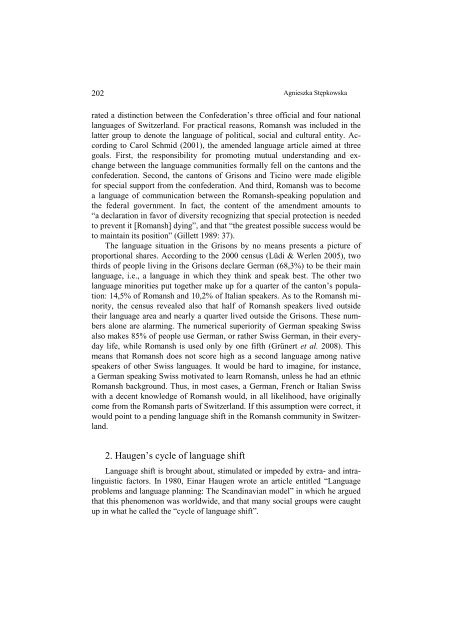s - Wyższa SzkoÅa Filologiczna we WrocÅawiu
s - Wyższa SzkoÅa Filologiczna we WrocÅawiu
s - Wyższa SzkoÅa Filologiczna we WrocÅawiu
You also want an ePaper? Increase the reach of your titles
YUMPU automatically turns print PDFs into web optimized ePapers that Google loves.
202<br />
Agnieszka Stępkowska<br />
rated a distinction bet<strong>we</strong>en the Confederation’s three official and four national<br />
languages of Switzerland. For practical reasons, Romansh was included in the<br />
latter group to denote the language of political, social and cultural entity. According<br />
to Carol Schmid (2001), the amended language article aimed at three<br />
goals. First, the responsibility for promoting mutual understanding and exchange<br />
bet<strong>we</strong>en the language communities formally fell on the cantons and the<br />
confederation. Second, the cantons of Grisons and Ticino <strong>we</strong>re made eligible<br />
for special support from the confederation. And third, Romansh was to become<br />
a language of communication bet<strong>we</strong>en the Romansh-speaking population and<br />
the federal government. In fact, the content of the amendment amounts to<br />
“a declaration in favor of diversity recognizing that special protection is needed<br />
to prevent it [Romansh] dying”, and that “the greatest possible success would be<br />
to maintain its position” (Gillett 1989: 37).<br />
The language situation in the Grisons by no means presents a picture of<br />
proportional shares. According to the 2000 census (Lüdi & Werlen 2005), two<br />
thirds of people living in the Grisons declare German (68,3%) to be their main<br />
language, i.e., a language in which they think and speak best. The other two<br />
language minorities put together make up for a quarter of the canton’s population:<br />
14,5% of Romansh and 10,2% of Italian speakers. As to the Romansh minority,<br />
the census revealed also that half of Romansh speakers lived outside<br />
their language area and nearly a quarter lived outside the Grisons. These numbers<br />
alone are alarming. The numerical superiority of German speaking Swiss<br />
also makes 85% of people use German, or rather Swiss German, in their everyday<br />
life, while Romansh is used only by one fifth (Grünert et al. 2008). This<br />
means that Romansh does not score high as a second language among native<br />
speakers of other Swiss languages. It would be hard to imagine, for instance,<br />
a German speaking Swiss motivated to learn Romansh, unless he had an ethnic<br />
Romansh background. Thus, in most cases, a German, French or Italian Swiss<br />
with a decent knowledge of Romansh would, in all likelihood, have originally<br />
come from the Romansh parts of Switzerland. If this assumption <strong>we</strong>re correct, it<br />
would point to a pending language shift in the Romansh community in Switzerland.<br />
2. Haugen’s cycle of language shift<br />
Language shift is brought about, stimulated or impeded by extra- and intralinguistic<br />
factors. In 1980, Einar Haugen wrote an article entitled “Language<br />
problems and language planning: The Scandinavian model” in which he argued<br />
that this phenomenon was worldwide, and that many social groups <strong>we</strong>re caught<br />
up in what he called the “cycle of language shift”.
















